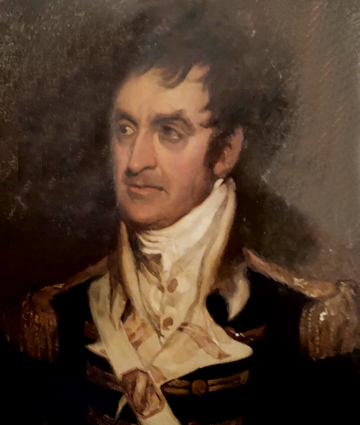 William Wadsworth (1761-1833) |
 History of the Wadsworths in Geneseo |
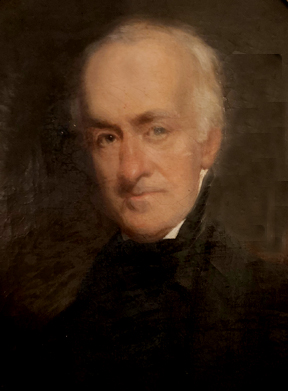 James Wadsworth (1768-1844) |
The Wadsworth Family has been synonymous with the name Geneseo ever
since brothers James and William Wadsworth (above) founded the town in
1789. They arrived after a long oxcart trip through the wilderness from
their home near Hartford, Connecticut. Sent by cousin Jeremiah
Wadsworth to help manage his large purchase of real estate in the
Genesee Valley, the Wadsworths have been an instrumental force in
developing the region, as well as significant figures on the national
stage.
Included as prior residents of the Hartford House are Civil War General James S. Wadsworth, the builder of the home, his son James W. Wadsworth, Sr. a U.S. Congressman, known by all simply as "The Boss." His son James Wadsworth Jr. was a United States Senator from 1914-1926, who followed that up with 20 more years as a Congressman. The Senator's son ,James Jeremiah "Jerry" Wadsworth ,served in the State Department negotiating Nuclear Arms Treaties and was United States Ambassador to the UN in 1960. Below are brief profiles of some of the major figures in the family, including some of the equally important ladies of the house.
Included as prior residents of the Hartford House are Civil War General James S. Wadsworth, the builder of the home, his son James W. Wadsworth, Sr. a U.S. Congressman, known by all simply as "The Boss." His son James Wadsworth Jr. was a United States Senator from 1914-1926, who followed that up with 20 more years as a Congressman. The Senator's son ,James Jeremiah "Jerry" Wadsworth ,served in the State Department negotiating Nuclear Arms Treaties and was United States Ambassador to the UN in 1960. Below are brief profiles of some of the major figures in the family, including some of the equally important ladies of the house.
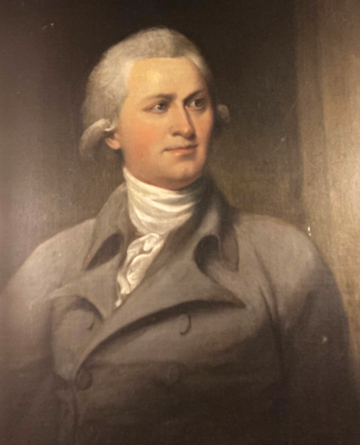 Merchant of Hartford, Ct. (1743-1804) |
The Wadsworths in Connecticut Although Western New York is the focus of our story, the history of the Wadsworths in America goes all the way back to the arrival of William Wadsworth on the good ship Lion in Boston in 1632. Like most arriving at that time, they were Puritans seeking religious freedom. The family lived for a few years in Cambridge, Mass, but not agreeing with the Boston Brahmins of that time they soon decamped along with the Rev. Thomas Hooker to found the Town of Hartford, Ct. Jerermiah Wadsworth, a wealthy merchant of Hartford, had served as Commisary General of the Revolutionary Årmy. After the Sullivan Expedition into Western New York in 1777 broke the power of the Seneca Indian Nation (who had sided with the British) many soldiers from New England returned with stories of an incredible rich farmland where corn grew 12 feet high! After the war, Jeremiah was able to purchase a large tract of land in the Genesee Valley east of the Genesee River. At that time title to land west of the river was still clouded by Indian claims. Being of advanced age Jeremiah retained his two young cousins James and William to settle the land. Jeremiah made his only trip to Western New York in 1797 to act as the Federal Commissioner to oversee the negotiations with the Seneca Indians that led to the Treaty of Big Tree. (Big Tree was the original Indian name for the area that became the Village of Geneseo, named after a large oak tree that grew on the banks of the Genesee River.) That treaty finally allowed sale of lands west of the river, so the entire valley could be developed. |
 James Wadsworth (1768-1844) |
The Geneseo Patriarch The original James Wadsworth turned out to be the patriarch of all the subsequent Geneseo Wadsworths. While his brother Bill had many adventures leading the militia against the British in the War of 1812, he never married or had children. James married Naomi Wolcott of Connecticut and they had 6 children, including two sons appropriately named William and James. In 1807, James completed work on The Homestead, a large mansion on the south end of Main Street in Geneseo.When he died he left that property to his son William. That house is still in the family, handed down through a succession of William Wadsworths to its current occupant Will, who operates a wedding venue there. Although James never sought public office, he was a strong advocate for public education, especially the "normalization" of teaching standards. It was partly due to his efforts that Geneseo became the site of a "Normal School" in 1871, now known as SUNY Geneseo. |
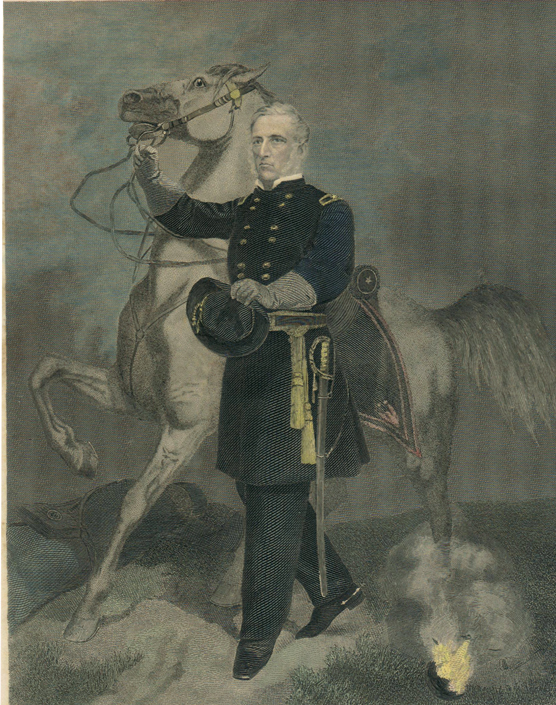 General James S. Wadsworth (1807-1864) |
The General The future General James Wadsworth was born in 1807, the same year that The Homestead was built. He was a spirited youth who was not compatible with the Ivy schools he was sent to. In 1834 he married Mary Craig Wharton of Philadelphia and took her to England on their honeymoon. While there, they visited the Villa of Lord Hertford in Regent’s Park, London. Gen. James liked the Villa so much he asked for and received the building plans. On return to Geneseo, he picked out a spot a mile north down Main Street and constructed the Hartford House in 1835. The original home was only two stories in the main section, however, after having 6 children, he raised the roof to add a 3rd floor in the 1854 to accommodate his growing family. (For more on the history of the English Hartford House click here.) The General took an active interest in politics joining the Free Soil Party which opposed the spread of slavery into the new western states in the 1840s, and later the Republican Party when it was formed in the 1850s. When the Civil War broke out he joined the fight despite his advance age of 54. He saw action at Gettysberg on the first day where his unit held off the Confederates arriving from the west, so the rest of the Union Army could form positions behind the town. He was close to President Lincoln and served for a time as the Military Governor of Washington, D.C. He ran unsucessfully for Governor of New York in 1862, partly because he refused time off from his military duties to campaign. He was mortally wounded at the Battle of the Wildnerness in Virginia on May 6, 1864 and died a few days later in the hands of the enemy. Many rebel soldiers came to view his body, as they could not believe a man of such wealth and age would actually be fighting in the war. The General was quite wealthy based on the family's ownership of a large acrerage of land which they rented out to tenant farmers on a "wheat rent" system. In those cash poor times, rent was paid by delivering so many bushels ofwheat to the Wadsworth's mill in Avon for every acre rented. He was also a philanthropist. In 1848 he sent a boatload of food to Ireland to help relieve the famine there. In 1861 he also sent another boatload of supplies to Washington, DC to evade a rebel blockcade. |
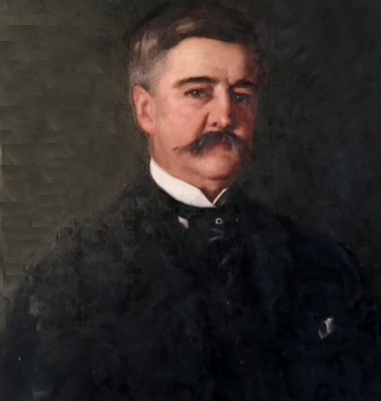 James W. Wadsworth Sr. (1846-1926) |
The Boss
Although
he
was the youngest of the General's three sons, he ended up
inheriting
the "Big House" upon the death of his mother in 1872. James
married
Louisa Travers of New York City and reigned over the
Hartford House and
the Valley for 54 years.
Also active in politics, he served in the NY State Assembly, as Comptroller of New York State and a total of 20 years in the U.S. Congress. He was active in the livestock business as a cattle raiser and also served on the Chicago Board of Trade. These interests put him at odds with Republican President Theodore Roosevelt who sought to regulate the meat packing industry. As Chairman of the House Ag Committee, Wadsworth tried to stop the legislation, unsuccessfully. His battle with Teddy cost him his House seat in 1908. The Boss retired to the more peaceful pursuits of farming and promoting his beloved baseball by organizing a semi-professional town team that recruited some of the best college talent in the nation. |
 James W. Wadworth, Jr.
(1877- 1952) |
The
Senator James
W. Wadsworth, Jr. was born into a political family, but he
soon exceeded even his father's success in that field.
In his first term in the State Assembly he was elected
Speaker at age 31.
A few years later in 1914, he became the first popularly
elected U.S
Senator in New York State history. (The 17th Amendment of
the U.S.
Constitution ratified in 1913 changed the method of electing
Senators.)
He spent two 6-year terms in the Senate before losing re-election in 1926 because he opposed Prohibition. A 3rd party "dry" candidate took enough votes away from him that he lost. A few years later he was back in Washington as a Congressman. He served 20 more years in Congress where his experience on the Senate War Committee during the first World War was very helpful as the country prepared to enter a second World War. In 1940 he co-sponsored the Burke-Wadsworth Act that allowed for the creation of a peace-time draft. The Act passed by just one vote and is credited with helping get the country ready for the oncoming war.The Senator married Alice Hay, daughter of Secretary of State John Hay who served from 1898-1905. More about her below. |
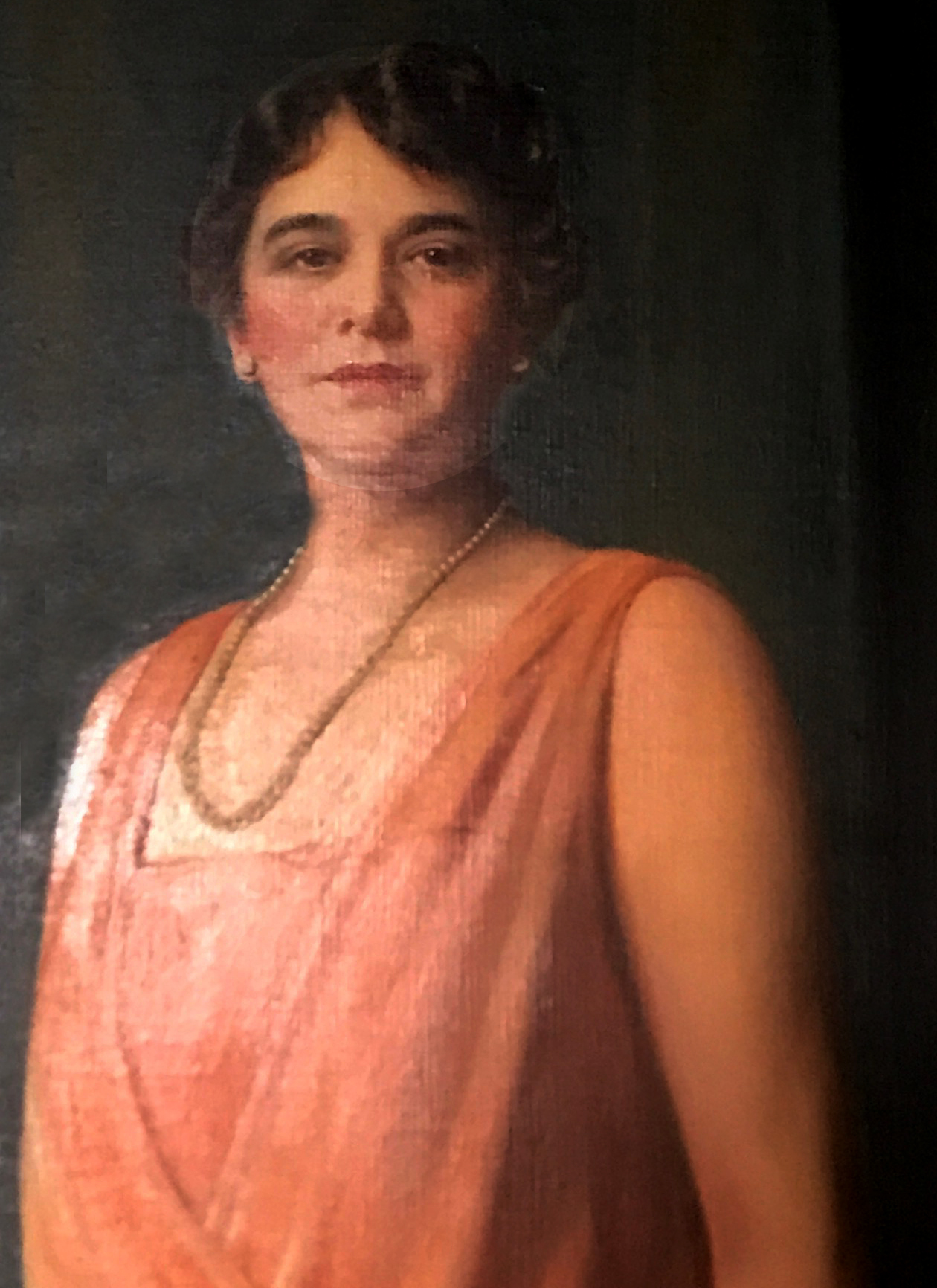 Alice Hay Wadsworth
(1880-1960) |
First
Lady of the House
Alice Hay was 50 years old by the
time her husband inherited the Big House. While her husband was
busy
with affairs of state, she was responsible with overseeing a
much
overdue remodeling of the house after the Boss's long reign.
Major
improvements included installing modern (for the time) plumbing
and
electrical service as well as creating the second floor
apartment that
would become The Garden Suite.
Just outside the Garden Suite window she created a walled garden, modeled after the one she had enjoyed in her youth at the Hay summer home, The Fells, located in Newberry, New Hampshire. She also saved the specially designed white mahagony panelling from her father's D.C. home when it was torn down in 1927. That was installed in the den on the south end of the house, which was her favorite place to sit. That den is now our Bridal Party changing room for our wedding venue. Born into and marrying into a political family, Alice was no shrinking violet. She served as national Chairperson of the National Association Against Women's Sufferage. She believed that government was,"a Man's job" and women should stay with traditional feminine roles of motherhood and family. After the 19th Amendment passed in 1920, she retired to less political pursuits. |
 James J. Wadsworth (1905-1984) |
The
Ambassador
The Senator and Alice Hay had three children, the eldest of which was named James Jeremiah Wadsworth, in honor of the original Jeremiah who had made the whole Western New York venture possible. Jerry as he was known, to distinquish him from all the James's in the family, attended Yale University where he played varsity baseball and also served as a drop-kicker on the varsity football team graduating in 1927. Shortly after graduation, he married Harty Tilton of NYC, and took her to Upstate New York for life on a dairy farm. Unfortunately the Great Depression had other ideas. Jerry went broke on the farm and was forced to move his family in with Dad on the 3rd floor of the Big House. In 1930 he followed the family tradtion by being elected to the State Assembly. He served 10 years there but never really warmed to retail politics, and besides, there was no upward mobility with his father holding the local Congressional seat. In 1940 with the war looming, he resigned his seat and went to work for the Curtiss Wright airplane factory in Buffalo. After the War, Jerry went to Washington where he received a number of political appointments. He spent many years in the State Department negotiating Nuclear Test Ban treaties with the Russians. He was serving as the Deputy Ambassador to the UN when his old friend Henry Cabot Lodge resigned as UN Ambassador to run as Richard Nixon's running mate in the 1960 election. He moved up to serve as Ambassador during the busy fall 1960 session of the UN when Soviet Premier Nikita Krushchev came to New York and banged his shoe on the lectern. Because of his busy diplomatic life, often out of the country negotiating, the Senator decided to leave the Big House to Jerry's younger brother Reverdy Wadsworth, who had stayed in Geneseo and run the farms. Reverdy and his wife Eleanor lived there from Alice Hay's death in 1960 until Rev's death in 1970; and Eleanor lived on there until 1975 when the house came back to Jerry's daughter Alice Wadsworth Strong. See below. |
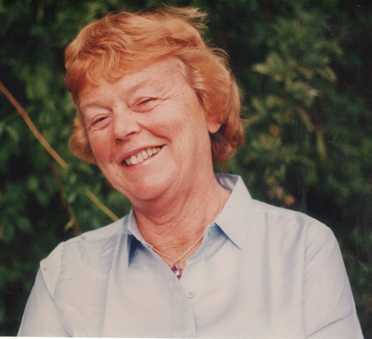 Alice Wadsworth Strong
(1928-1998) |
The
Strongs take over!
Alice Wadsworth Strong was the only child of Jerry & Harty Wadsworth. She mainly grew up in the Hartford House, spending the fall term in Geneseo public school and the Spring term in Albany, when her father was in the Assembly from 1930-1940. Later she attending and graduated from the Park School in Buffalo, after her father took a full time job with Curtiss-Wright Aircraft Company. She attended Bryn Mawr College for one year and then dropped out to marry Trowbridge 'Toby" Strong of Washington, DC. The marriage was held in the Formal Garden at Hartford House in 1948 and because of the Senator's prominence over 1,000 guests attended. She and Toby settled in suburban Philadelphia where they raised a family of 5 children. In 1975 when it looked like Hartford House was going to be put on the market she and eldest son Corrin Strong, persuaded Toby to buy the property from Alices's Aunt Eleanor. Alice was thrilled to own her old childhood home and made many improvements including installing the swimming pool (a gift from her father Jerry Wadsworth) and a complete renovation of the kitchen. While maintaining her permanent home in Narberth, Pa, she loved to come to the Valley in the summer and especially for the Fall "Hunt Season." She and Toby endowed a lecture series at the college in honor of her father James J. Wadsworth that has brought many well-known speakers to the Valley, including former Presidents Gerald Ford and George H.W. Bush. |
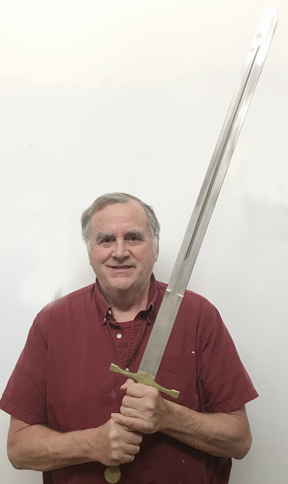 M. Corrin Strong
(1950- |
Your
Host
Corrin Strong is the oldest child
of Alice and Toby Strong and the 6th Generation of the family to
own
the Big House. Raised in suburban Philadelphia, he dropped out
of
college after his sophomore year in 1970 and went back to the
land on a
small farm on the Mason-Dixon line in York County, Pa.
In 1975, after persuading his parents to buy the Hartford House he moved to Geneseo and finished up his college requirements at SUNY Geneseo and then attended Albany Law School. It was there he met and married his wife Judith Allen. They had 4 children together before divorcing in 1998. After law school Corrin practiced law part time and expanded into large scale farming, operating a 600-acre grain farm on family land in Caledonia, NY. He never made any money farming and finally quit in 1993. He had already "retired" form the practice of law after 5 years. In a long and varied entrepreneurial career, he has also been involved in the retail clothing business, published a weekly newspaper and a regional magazine, Genesee Country, from 1993-2001. He currently operates four businesses in addition to the Bed & Breakfast: Genesee Graphics, a print and copy shop on Main Street; Free Soil Farm, a small vegetable farm on the property; the Genesee Volley Tennis and Croquet Club in the back yard and Hartford House Weddings and Events on the property. He became the owner of Hartford House in 2001 after the death of his father. In the last 20 years he has added a Har-Tru tennis court and renovated the house to add the four B & B units. He also built a 2,100 square foot addition on the north end of the house where he resides with his partner and B & B co-host Kim, His latest project is the construction of a family museum and genealogy center for the Wadsworth family in the B & B lobby (front hall.) He has named that venture the Gen. James S. Wadsworth Institute for History and Genealogy in honor of the General. (See web site at www.WadsworthInstitute.org) During your stay Corrin is available to give tours of both the museum and the historic house. Just like his great-great-great grandfather, Gen. James S. Wadsworth, who built the house, Corrin carries on the tradition of fighting against modern forms of slavery and wields his "Sword of Truth" as an anti-lockdown activist. |
Return to Main B & B page